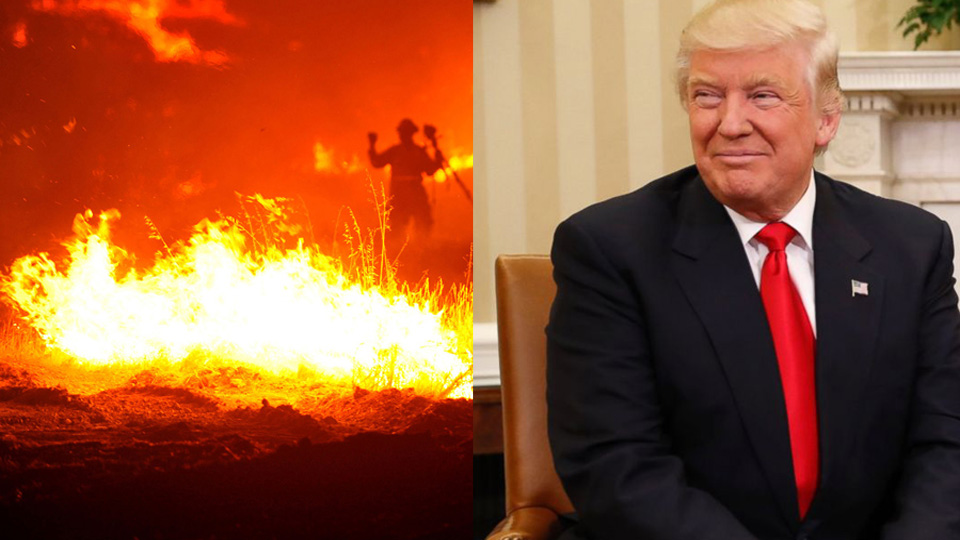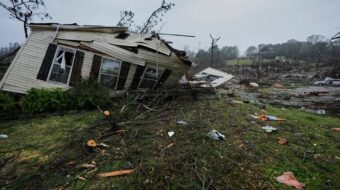
Across the U.S., an uncommon heat wave has caused Americans to feel firsthand the effects of global warming, but it would seem that President Trump is numb to it. In his first budget plan, he will look to slash funding to the Environmental Protection Agency, while drastically increasing military spending. In particular, sources predict “massive, transformational cuts” to EPA climate change programs.
According to the New York Times, cabinet and agency officials were asked Feb. 27 to prepare budget requests ahead of the Trump administration’s budget release on Mar. 13. The largest target for “deep funding cuts” is the EPA, which could be decimated in exchange for Trump’s promised boost in defense spending. Though the budget plan will likely be altered by House and Senate Republicans, and opposed by congressional Democrats, it will nevertheless strip tens of billions of dollars from the EPA, as well as the State Department, according to four senior administration officials.
The repercussions these cuts will have on the environment will be numerous, but they will also affect jobs. According to Politico, “The White House has proposed slashing the EPA’s budget by about a quarter, and eventually eliminating one in five of the agency’s workers, according to sources familiar with the budget proposal sent to the EPA on Monday,” Feb. 27. This would essentially be “reducing the EPA’s 15,000-strong workforce to 12,000, a level not seen since the mid-1980s.”
All this for a $54 billion increase in U.S. defense spending, during a time when the U.S. military budget is larger than that of seven other nations combined (the Pentagon has said in recent years that it does not need more money), and when the global warming catastrophe is worse than ever.
Consider the current effects of the climate change-driven heat wave in the U.S., which are occurring as President Trump turns a cold shoulder to the entire crisis:
The Colorado River is parched and dwindling
Climate change has officially been cited as the culprit behind the parched and dwindling Colorado River. New data from the Water Resources Research shows that during the first 14 years of the 21st century, its flow declined to just four-fifths of the 20th century average; the water lost would have been enough to supply two million people for a year, according to EcoWatch. The river currently supplies water to seven U.S. states and part of Mexico
This, said the study, “combined with the increasing likelihood of prolonged drought,” which the river itself has experienced since at least 2000, “suggests that future climate change impacts on the Colorado River flows will be much more serious than currently assumed, especially if substantial reductions in greenhouse gas emissions do not occur.”
70 degrees in February – and that might become more frequent
Though President Trump might have grown accustomed to his air conditioned hotels, the temperature outside has been noticeable to most U.S. citizens currently experiencing an abnormal period of record warmth. The New England region endured a heat wave comparable to June-like levels, along with harsh storms, rapidly melting snow, and more hot weather on the way.
Though February temperatures have consistently been on the rise for over 100 years, they have reached record-breaking increases as of late, and that, combined with a decrease in the overall amount of winter days with snow cover, have climate scientists worried for the same reason they fret over the melting ice in the Arctic: without that cover, the chilling effect of the snow is lost, sending temperatures upward.
The National Center for Environmental Information revealed that this February has experienced 336 monthly record highs either set or tied, along with 203 records set or tied for the warmest overnight minimum temperature. Deke Arndt, leader of the NCEI’s climate monitoring branch, talked about the past week, noting that it has offered scientists “a close-up look at the DNA of what we are seeing in the big picture: relative to historical norms, extreme heat continues to outpace extreme cold across almost every place, season, and time of day in the USA.”
This forest fire season will be hot and devastating
Though the winter is still upon us, mid-February marks the official start of the spring forest fire season for parts of the U.S. – and if the wildfires of recent years are any indication, this forest fire season will be just as hot and devastating as those that preceded it.
In terms of brushfire outbreaks, things certainly have not gotten off to a very docile start. On Feb. 21, Kentucky experienced one of the worst blazes it has endured in years, when a wildfire tore through the eastern part of the state, torching hillsides along highways and threatening power and gas lines. More than 5,000 firefighters are dealing with blazes in the total fire zone.
And although a recent study shows that humans cause most wildfires, University of Utah fire scientist Philip Dennison outlined an important clarification: “Climate change loads the dice toward warmer, drier conditions that make it more likely that a fire will develop from human-caused ignitions.”
An ongoing attack
The Trump administration’s ongoing attack on the EPA and anti-climate change policies has worried many, with the Paris Climate Agreement, the Clean Power Plan (which reduces power plant emissions), and even the very existence of the Endangered Species List under attack.
According to some, these anti-environment moves are worse than ever before. Christine Todd Whitman, who served as the Bush administration’s EPA chief from 2001 to 2003, remarked, “They challenged science in the Bush administration, but it wasn’t this constant drum beat. The Trump team is undermining the credibility of science, and that is certainly very concerning.”











